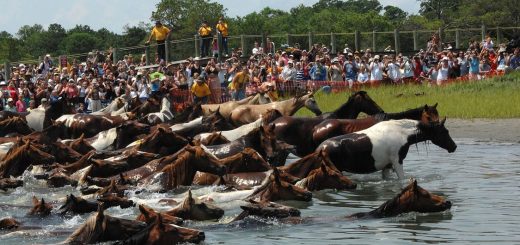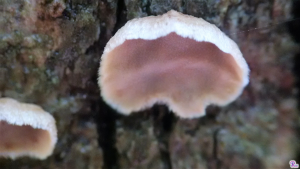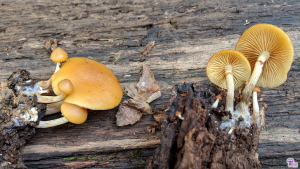#115: Neotyphodium coenophialum, Tall Fescue Endophyte
This fungus spends its entire life inside Tall Fescue, a common livestock feed grass. While it is beneficial to the plant, it makes animals that feed on the grass sick. In the United States, the fungus costs the beef industry from $600 million to $1 billion or more every year.
What is an endophyte? If you took Latin, you can probably guess the answer: “endo-” means “in” and “-phyte” means “plant.” Therefore, an endophyte is an organism that lives inside a plant. This is an ecological group, so organisms that fill a previously-defined ecological role (such as plant parasites and mycorrhizal fungi) are generally excluded. The resulting group contains organisms (mostly bacteria and fungi) that are mutualistic to mildly parasitic with their plant hosts. Almost all plants are infected with endophytes. Evergreen plants contain the highest numbers of endophytes in their leaves, since the slow-growing organisms have time to colonize the leaves. Endophytes interact with their hosts in a variety of ways and we are really just starting to become aware of how important these invisible organisms are.
Tall Fescue (Festuca arundinacea) is a perennial grass from Europe that is used in a variety of contexts, including as livestock feed, as turf, and for controlling erosion. It was first introduced to the United States in the early 1800’s. In 1931, a strain was discovered in Kentucky that had adapted to growing conditions in North America. This strain was named “Kentucky 31” and became very popular as a feed source for livestock beginning around 1945. It is resistant to many insects and nematodes, tolerant of poor soil, and survives well during times of drought. All these qualities make it very easy for farmers to establish and maintain stands of Tall Fescue. Importantly, the grass also produces a good yield of leaves and seeds that can be eaten by grazing livestock. Today, Tall Fescue is planted on over 36 million acres in the United States.
Soon after the use of Tall Fescue became widespread, farmers began noticing that grazing animals on fescue produced inconsistent results. On many farms, animals fed Tall Fescue performed poorly and developed health problems. Some would even lose weight even when constantly grazing. Cattle, sheep, horses, and deer were all susceptible to these effects, though to different degrees. There are three main diseases associated with Tall Fescue: Fescue Toxicity, Fescue Foot, and Bovine Fat Necrosis.
Fescue Toxicity affects cattle, sheep (to a lesser extent), and deer, which will demonstrate most or all of the following symptoms: “(1) reduced feed intake; (2) decreased weight gain; (3) lower milk production; (4) higher respiration rate; (5) elevated body temperature; (6) rough hair coat; (7) more time spent in water and/or shade; (8) less time spent grazing; (9) low blood serum prolactin concentration; (10) excessive salivation; (11) lower reproductive performance.”* Horses also demonstrate problems during reproduction, including: “abortions, prolonged pregnancy, foaling problems that can result in foal and/or mare deaths, thick or retained placentas, and agalactia (little or no milk production).” Most of the foals that survive are born with developmental, mental, and immunological problems. Pregnancy relies on very accurate chemical signaling, so even low levels of toxic fescue will cause problems in horses.
Fescue Foot is a gangrenous condition (resulting from extremely decreased blood flow to the extremities) and is a particular problem in colder weather. It often results in lameness, the loss of tail or ear tips, or both. In its most extreme form, animals may lose their hooves or even their feet. Cattle and sheep are the two animals most often affected by fescue foot.
Bovine Fat Necrosis affects cattle and is characterized by the production of hard, fatty masses in the tissue surrounding the intestines. These fatty masses can interfere with both digestion and calving. This disease is only a problem in fields that are heavily fertilized.
It was not until the 1970’s that the cause of these problems was discovered. Researchers managed to isolate Neotyphodium coenophialum from the disease-causing fescue. This small ascomycete was found to grow between the cells of Tall Fescue and did not produce any directly observable differences between infected and uninfected plants. Even today, a lab test is required to tell whether or not endophytes are present in Tall Fescue. Further research showed that the fungus produces a variety of alkaloids that deter predation. These alkaloids are very similar to those produced by the fungus Claviceps purpurea (Ergot of Rye, see FFF#061), which causes similar disease symptoms in humans.
N. coenophialum has a very simple life cycle. It begins its life inside a fescue seed, where it can survive for up to a year. When the seed germinates, the fungus grows into the base of the leaf. The “infection” remains there until the plant forms reproductive structures. Then, the fungus grows into the stem and eventually into the plant’s seeds. The seeds are dispersed by the wind or by animals (especially humans), thereby spreading the infection. Under normal conditions, N. coenophialum does not produce spores. Therefore, infection is only spread from the parent grass to the child grasses and plants remain infected or uninfected for life.
“Infection” is a strange word to use to describe the relationship between N. coenophialum and Tall Fescue. It is technically accurate, since the fungus lives inside the plant’s tissues and gets all of its nutrients from the plant. However, unlike a normal disease, N. coenophialum confers many benefits to its host. Endophyte-infected plants are resistant to insects, resistant to nematodes, drought tolerant (due to “improved osmotic adjustment, greater sugar accumulation, better root growth, and more leaf rolling to conserve water”*), and tolerant of many types of stress. Of course, the endophyte-infected grass also harms large animals that eat it, which serves to decrease the likelihood that the grass is eaten (which is a good thing from the grass’s perspective). Most of these effects appear to be mediated by various alkaloids produced by the fungus. Only a few of these alkaloids are harmful to livestock.
So why would the fungus produce extra compounds just to help the plant survive? Wouldn’t the fungus be able to grow more if it didn’t devote resources to making those compounds? Well, no. Here’s why: N. coenophialum is effectively a sexually transmitted infection of Tall Fescue. The fungus reproduces by growing into the plant’s seeds. Consequently, the more seeds the fescue produces, the more plants are infected by the fungus. N. coenophialum therefore has an incentive to help make the plant as productive as possible.
However, supporting the fungus does come at a cost to the plant. Some of the plant’s energy is required to feed the fungus, so endophyte-free grass does better under ideal conditions. Combined with the fact that the endophyte is only passed from parent to child, this means that a properly managed stand of grass can remain endophyte-free for a long period of time. Endophyte-free stands do best in cooler climates where there is available moisture and when the grass is not grazed or only lightly grazed during the summer. The more stress a stand of Tall Fescue is put under (intensive grazing, more pests, warmer/drier weather, etc.), the more likely it is to become dominated by endophyte-infected plants.
There are a number of things farmers can do to reduce the impact of N. coenophialum on livestock. One of the most interesting is to plant Tall Fescue infected with “novel endophytes.” Researchers have identified a number of endophyte strains that do not produce the alkaloids that are toxic to livestock. The first commercially-available product using these novel endophytes came onto the market in 2000. Tall Fescue infected with novel endophytes has stress tolerance comparable to Tall Fescue infected with wild, toxic endophytes. This confers the benefits of endophytes without having to worry about the toxic effects on livestock.
There are other methods available to help farmers control the amount of toxins that livestock. The simplest method is to kill off all the grass and re-seed with uninfected fescue. To keep stands endophyte-free, livestock feeding on infected Tall Fescue should be moved to another crop for at least three days before being transferred to an uninfected pasture. This will prevent endophyte-infected seeds from being introduced to the new pasture through the animals’ feces. Another option is to move livestock off of fescue during the summer months. High temperatures increase toxicity, so this strategy would avoid the most problematic time of year and reduce the stress on the fescue. Reducing the concentration of fescue in a pasture by planting a second forage crop (normally a legume) in the same pasture can also help to lower toxic effects. Similarly, farmers can supplement their animals’ diet by providing feeds such as corn. Avoiding excessive fertilization can greatly reduce the toxic effects of endophytes. Within a plant, toxins are most concentrated in the seeds and stalk supporting the seeds. As a result, toxic effects can be reduced if Tall Fescue is grazed closely and not allowed to produce reproductive structures. If livestock are fed by infected fescue hay, ammoniation of the hay can help decrease the effectiveness of the toxins. Additionally, the medication Domperidone can be given to pregnant horses to mitigate the effects of endophyte toxins. Unfortunately, this drug is not cost-effective for other animals.
See Further
http://extension.missouri.edu/p/G4669
* https://www.uky.edu/Ag/Forage/Tall%20Fescue%20Endophyte%20Concepts%20for%20Web.pdf
http://extension.uga.edu/publications/detail.cfm?number=C861
http://www.wvu.edu/~agexten/pubnwsltr/TRIM/5026.htm
http://www.merckvetmanual.com/mvm/toxicology/mycotoxicoses/fescue_poisoning.html








![#011: Characteristics of Kingdom Fungi [Archived]](https://www.fungusfactfriday.com/wp-content/themes/hueman/assets/front/img/thumb-small-empty.png)



1 Response
[…] of these do not cause the plant any harm and some even benefit their host plants (for more, see FFF#115). In the case of T. cacao, it is hoped that trees inoculated with the fungal endophyte […]